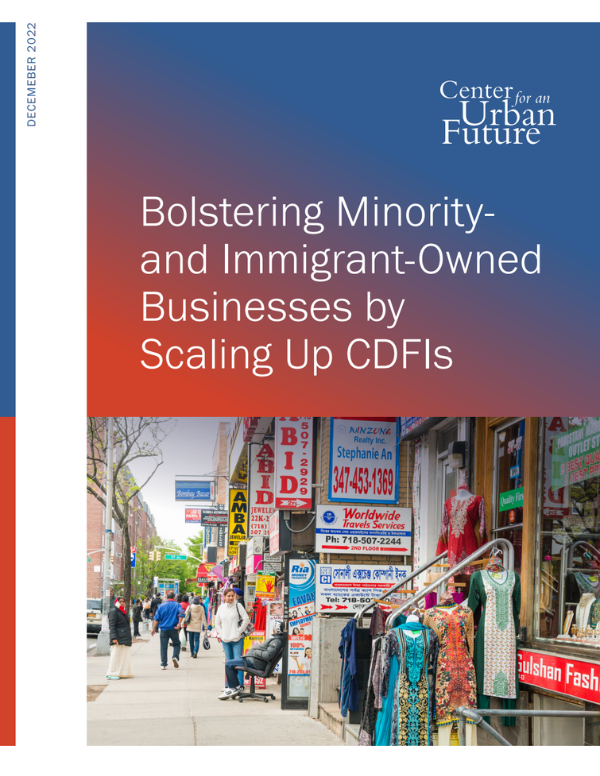Neighborhoods across New York City—from the South Bronx to Sunset Park—are experiencing an unprecedented entrepreneurial renaissance. The number of new business applications increased by 30 percent from 2019 to 2021, with the fastest rate of growth occurring in the Bronx (a 66 percent increase). But it's not yet clear if most of these new enterprises will be able to survive, let alone thrive. If the past is an indicator, a disproportionate share of the city's minority- and immigrant-owned firms will close down or fail to achieve meaningful growth.
It’s important that New York policymakers take steps to make sure things are different this time around—and that the city’s newest businesses have the tools and resources to succeed.
On June 20, the Center for an Urban Future (CUF) and Wells Fargo convened a forum exploring what exactly city government officials should do to ensure that a significant share of the city's newest businesses prosper for many years to come. Our forum, titled “Sustaining NYC’s Entrepreneurial Boom: Helping the City’s Newest Businesses Succeed and Grow,” gathered two expert panels featuring private and public sector leaders in small business growth from across the five boroughs. Seven clear policy ideas emerged from the discussions:
1. Help small businesses reach more customers. More than anything else, small businesses need customers—and the city’s economic development agencies have several innovative and relatively inexpensive options for doing just that. For example, city officials should:
- Provide grants supporting neighborhood-specific events or tours that bring New Yorkers and tourists to commercial districts outside of Manhattan. For example, the nonprofit lender Accompany Capital spent the relatively small sum of $3,000 to sponsor the annual Momo Crawl in Jackson Heights—a tour of the neighborhood’s many eateries serving these distinctive Himalayan dumplings—which brought approximately 3,000 people to the neighborhood, generated a one-day sales blitz for local restaurants and vendors, and helped establish a foundation of future customers.
- Hire a team of social media experts specifically to help create awareness and buzz about specific New York businesses and commercial districts—or give Business Improvement Districts (BIDs) and merchants associations funds to do so. The city’s economic development and tourism promotion agencies should tap the New York–based creators going viral every day on TikTok and Instagram to draw attention to more small businesses across the five boroughs, perhaps modeled on the highly successful social media marketing of businesses along Tompkins Avenue in Bed-Stuy.
- Allocate resources to establish New York versions of entities like Buy from a Black Woman, a national community of entrepreneurs that facilitates revenue-boosting partnerships for local businesses—from creating pop-ups in major retailers to tours that generate sales.
2. Boost marketing of existing small business assistance programs. Remarkably few small firms across the five boroughs are even aware of the small business assistance programs offered by the city’s Department of Small Business Services (SBS) or by nonprofit organizations, a major missed opportunity since many of these programs provide valuable technical assistance and one-on-one business advising. Ensuring greater participation in these existing programs would strengthen new and existing businesses and help them avoid or overcome the challenges that too often overwhelm small firms. To create greater awareness, SBS should launch a sustained marketing campaign in partnership with BIDs, Chambers of Commerce, merchants associations, ethnic and community newspapers, and local elected officials. The agency should also greatly increase marketing on the social media channels and platforms that are most widely used in specific communities. As SBS Commissioner Kim noted in our recent forum, it will be difficult to reach entrepreneurs in New York’s Chinese community if you aren’t using WeChat, New York’s Korean community without using the platform Kakao, and New York’s Latino entrepreneurs without WhatsApp.
3. Help new businesses avoid the bookkeeping mistakes that too often end up foiling plans for growth down the road. Countless businesses in New York miss out on opportunities to access loans and grants that could help them grow due to challenges establishing standardized bookkeeping systems in their earliest months. Many new entrepreneurs simply aren’t aware that having accurate records is a prerequisite to accessing future sources of capital like bank loans down the road. Many others implement insufficient bookkeeping practices after receiving bad advice from friends and family members. "Through our small business network, we're learning more and more about what these small business entrepreneurial individuals need, and I think education, above everything else, on how to prepare their finances [is needed],” said Lisa Sorin, president of the New Bronx Chamber of Commerce. “During Covid, [we saw] how unprepared the financials are for the majority of these businesses. Their books were everywhere. They weren’t prepared … for these major loans or for access to other capital.” To ensure that this gap in knowledge and experience does not act as a barrier to growth, city leaders should create a technical assistance fund that enables Community Development Financial Institutions (CDFIs) and other trusted community organizations to significantly increase outreach to businesses established since the pandemic, enabling their business advisors to ensure that recently created businesses are using record-keeping systems that will set them up for success.
4. Help close the capital gap for growing businesses. While entrepreneurs at all levels struggle to access capital, one of the biggest gaps for borrowers is at the level between microlenders (which typically lend in amounts under $50,000, and mostly under $10,000) and banks (which rarely make loans under $1 million). As small businesses look to grow or deal with emergency expenses that are critical to survival, they often need loans between $50,000 and $500,000. There are only a few CDFIs that provide financing in these amounts, and there’s currently little incentive for banks to make loans at these levels. City and state officials should create new incentives that entice lenders to make more loans in this range. One option may be to expand the city’s Capital Access Loan Guaranty Program, which guarantees up to 40 percent of eligible loans from participating lenders to small businesses.
5. Expand the reach and impact of New York's CDFIs. Although New York is home to dozens of excellent small business development organizations, the relative handful of nonprofit Community Development Financial Institutions across the five boroughs stand out for their unique ability to connect the city’s smallest, most vulnerable businesses with access to capital and technical assistance. CDFIs have built up trust with immigrant- and minority-owned businesses and are often the only place where first-time and smaller-scale entrepreneurs can get financing. The problem is that CDFIs across the city serve only a tiny fraction of the businesses and aspiring entrepreneurs who could benefit from affordable loans and business advising services. The biggest challenge facing CDFIs is not a lack of lending capital, but rather extremely limited operating funds, which leaves them with too few staff to underwrite more loans and provide the one-on-one business advising that so many entrepreneurs need, and too little money to invest in technology that would enable them to be more efficient in their loan process. Mayor Adams and the City Council should create a new CDFI capacity-building fund that would provide multi-year grants for CDFIs to increase investments in staffing and technology, ultimately helping them to deliver the personalized support that small businesses require to succeed.
6. Strengthen the business community support network through a more robust mentorship program. When small business owners and entrepreneurs first open up shop, they are often overwhelmed with their new responsibilities and can struggle to make the right decisions to ensure their business grows and succeeds. To help these new small businesses thrive, the city should push to create a mentorship system across all five boroughs in which new business owners can learn from their more experienced counterparts or provide investment to scale up existing networks. By actively recruiting new mentors that can work to provide guidance, offer advice, and hold routine networking events for small business owners, the city can help cultivate a stronger and more interconnected entrepreneurial environment and leverage trusted messengers to boost awareness of effective programs and services. Danielle Chery, founder of DMC Original Art, said that SCORE—one of the city’s oldest mentor networks—was a tremendous help in bolstering her financial acumen as an artist creating her own business.
7. Create new opportunities for home-based businesses by turning vacant retail spaces into pop-ups and harnessing the Open Streets program. Since the start of the pandemic, small businesses have been popping up across the five boroughs, and many of them operate out of their homes. But without a storefront, it can be a challenge to connect with their local community and expand sales. To address this gap, the city should work to create more public space marketplaces where small businesses can sell their products. One idea is to build on the Department of Transportation’s Open Streets program by dedicating one weekend of every month in the warmer months as a “small business weekend” at participating locations. On Tompkins Avenue, the Bridge Street Corporation in partnership with the Tompkins Avenue Merchant Association holds TAMA Sundays—a weekly summer festival, featuring BIPOC-owned businesses in the local community, which has created a marketplace for small businesses and new streams of revenue for entrepreneurs. The city should learn from this model and seek to replicate it in other communities. Additionally, city officials should work with BIDs and other intermediaries to develop a small business pop-up program in vacant storefronts on busy pedestrian corridors.
This policy brief was informed by the June 20 forum held by CUF and Wells Fargo, which was moderated by CUF Editorial and Policy Director Eli Dvorkin and featured the following speakers:
Commissioner Kevin Kim, NYC Department of Small Business Services
Council Member Kevin Riley, New York City Council
Gregg Bishop, Executive Director, Social Justice Fund, Joe and Clara Tsai Foundation; Former SBS Commissioner
Danielle Chery, Founder, DMC Original Art
Blondel Pinnock, CEO & President, Bedford Stuyvesant Restoration Corporation
Lisa Sorin, President, The New Bronx Chamber of Commerce
Yanki Tshering, Founder & Executive Director, Accompany Capital




